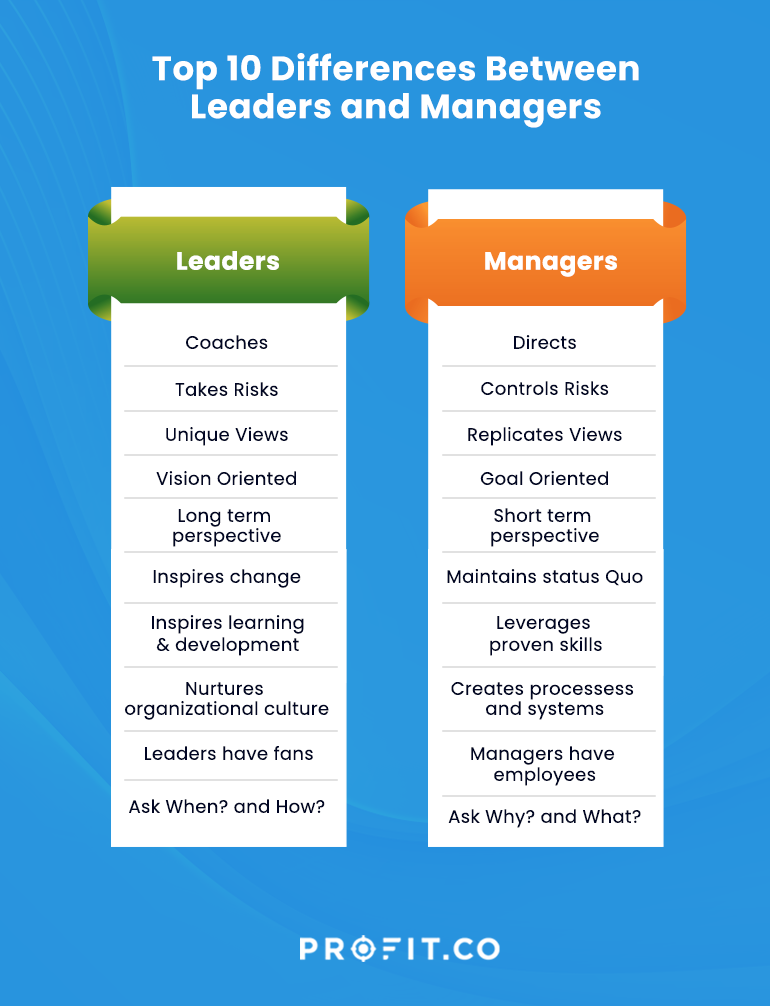Both managers and leaders are essential members of every team and are very important for all team-building activities. Managers are vital links between the stakeholders and the company as they perform standard managerial tasks. On the other hand, leaders influence, encourage, and inspire people to willingly perform duties that contribute to achieving the objectives.
As an HR manager, it can be challenging to determine whether an individual should be a leader or a manager. Often, the desired traits between both roles overlap in employees. Let’s explore what it takes to be a leader and manager as we discuss ten differences between them.
Who is a Leader?
A leader relies on human contribution to achieve goals rather than displaying or possessing power. Leaders can work in various parts of an organization and are not necessarily in charge.
Ready to start your leadership journey?
An effective leader should have strong personality and leadership skills such as
- Open-mindedness and creativity
A good leader is always open and accepting of new perspectives and ideas. They are always willing to change, observe and listen while encouraging the team to follow suit.
- Empathy
A leader must be empathetic to help nurture a strong bond with team members and resolve complaints or issues.
- Communication skills
Leaders have excellent communication skills. They are always honest and transparent with the team about successes and failures.
Management is about persuading people to do things they do not want to do, while leadership is about inspiring people to do things they never thought they could.
Who is a Manager?
A manager is a crucial pillar as they ensure smooth operations while monitoring the daily activities. These tasks can be challenging, so a manager should exhibit personality traits and skills that allow for a cohesive work environment.
An effective manager should have strong managerial skills like
- Effective communication
A good manager should be an excellent communicator and possess outstanding interpersonal skills to prevent internal conflicts.
- Use process management
Managers implement the proper ethics and positive company culture. Therefore, a manager should clearly understand the company’s goals and vision.
- Be dependable and trustworthy
A manager should be dependable, trustworthy, and easy-going so team members can approach, depend on and trust them.
Top 10 Differences Between Managers and Leaders

So, how can you differentiate a leader vs. a manager? Here are ten key differences between the two:
- Managers Direct, but Leaders Coach
Leaders consider the team competent and positively perceive their potential. They avoid telling team members what to do and how. Managers, on the other hand, delegate tasks and offer guidance on how to fulfill them.
- Managers Control Risks, While Leaders Take Risks
Leaders are inclined to try new things, even if it means failure. They look at failure as a stepping stone to success and are better at risk management. Managers strive to lower risks and control or prevent issues instead of embracing them.
- Leaders Have a Unique View, but Managers Replicate It
Leaders actively work to build a unique personal brand. They are transparent, authentic, and unafraid of standing out. Managers learn behaviors and skills from others and adopt a pre-defined leadership style.
- Managers Set Goals, but Leaders Have a Vision
When comparing a manager vs. a leader, leaders have a vision and mobilize and inspire team members to make it a reality. A manager focuses on defining, measuring, and attaining goals while controlling occurrences to achieve these objectives.
- Leaders Have a Long-term Perspective, but Managers Look at Things Short-term
Leaders have a purpose and remain motivated by a more significant long-term goal without needing regular rewards. Managers require regular accolades because they focus on shorter-term goals.
- Managers Preserve the Status Quo, but Leaders Inspire Change
Leaders take pride in innovation and inspire change management even in uncertainty. Managers prefer what is already working, so they work on refining and enhancing the processes, structures, and systems.
- Managers Leverage Proven Skills but Leaders Experience Personal Growth
Leaders embrace learning and aim to retain relevance in the dynamic workspace. Managers focus on the skills that result in success and try to perfect these proven behaviors and abilities.
- Managers Create Processes and Systems, but Leaders Nurture Relationships
Leaders need people to actualize their vision, so they build trust and loyalty by honoring promises. Managers focus on the systems and structures necessary to achieve the desired outcomes and goals.
- Managers Have Employees, while Leaders Have Fans
Leaders get followers who become die-hard fans who help attain goals. Managers have employees who abide by instructions.
- Leaders Ask Why and What, but Managers Ask When and How
When faced with a challenge, a leader looks at why it happened and what they can learn from the experience. They exhibit great situational leadership skills.
A manager considers when and how the challenge occurred to ensure the proper procedures or plans are in place to avoid such occurrences.
FAQs
- What are the similarities between management and leadership?
Both require defining objectives, developing strategies to achieve them, and tracking the progress. Doing so calls for strategic thinking, problem-solving, effective communication, and collaboration.
- Who is more essential, a leader vs. a manager?
Both managers and leaders are vital to a company. Managers organize teams to achieve objectives, while leaders enhance the company’s ethics and values.
- What is the difference between leadership and management?
The main difference between leadership and management is that management focuses on daily tasks and related issues. However, leadership focuses on nurturing the right culture and motivating employees to align with the company’s vision.
Conclusion
Although managers and leaders seem different, seeking a well-rounded individual who can balance both skill sets is best. Some challenges require strong leadership skills to provide direction to the team, while others require focusing on execution.
Leadership is multifaceted and challenging to measure. Metrics and KPIs such as team performance, turnover rates, and employee engagement rates can help gauge leadership. Several metrics can help you evaluate a manager’s effectiveness, such as financial performance, productivity, and employee satisfaction.

